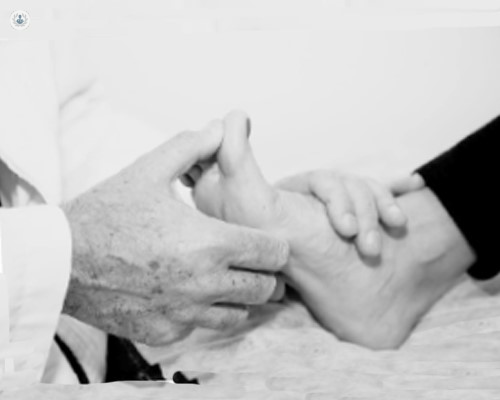Foot fracture
Mr Tarek El Gamal - Orthopaedic surgery
Created on: 11-13-2012
Updated on: 03-23-2023
Edited by: Sophie Kennedy
What is foot fracture (broken foot)?
A foot fracture is a break in any of the bones of the foot (tarsus, metatarsals and phalanges). The injury occurs by direct trauma or excessive load on the bone. The seriousness of a broken foot can vary. Fractures can range from tiny cracks in your bones to a break that pierces through your skin.

What are the symptoms of a broken foot?
Symptoms of a broken foot include:
- Throbbing pain
- Pain when moving but subsides when resting
- Swelling
- Bruising
- Tenderness
- Misshapen
- Difficulty in walking
What are the causes of a broken foot?
The common causes of a broken foot include a car accident, tripping or falling awkwardly on your foot, impact from a heavy-weight, such as dropping something heavy on your foot, or even stress on the foot from overuse. Tiny cracks can be caused over time by repetitive force, which includes running long distance.
Risk factors of a broken foot or ankle come from stresses or direct blows from high-impact sports, or the improper technique or use of sports equipment. A sudden boost to your activity level can also increase the risk of a stress fracture. If you have a medical condition such as osteoporosis, it can put you at risk of injuries to the bones in your feet.
How is a broken foot diagnosed?
You will have a medical examination with your doctor who will check the points of your foot that are tender. Your doctor may also suggest an X-ray, bone scan, CT or MRI scan so that they can reveal more detail about the exact bone fracture that you are experiencing.
How is a broken foot treated?
The treatment option will depend on which bone in the foot has been broken and just how severe the injury is that you have sustained. It may be recommended to take over-the-counter pain relief medication. Once the bone has healed, a physical therapist can teach you exercises that you can do at home.
In some cases, a cast may be required. Minor foot fractures may only need a removable brace or shoe with a stiff sole. If surgery is necessary, an orthopaedic surgeon will use pins, plates or screws to help the positioning of the bones during healing. These can later be removed once the fractured has healed.










